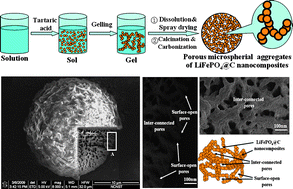Novel porous micro-spherical aggregates of LiFePO4@C nanocomposites have been synthesized in large quantities via an improved sol–gel method combined with spray drying technology (sol–gel-SD method), which required no surfactants or templates. With this new procedure, a precursor was prepared through the process of sol–gel and subsequent spray drying. A series of analyses, including X-ray diffraction (XRD), X-ray photoelectron spectroscopy (XPS), energy dispersive X-ray (EDX), scanning electron microscopy (SEM), high-resolution transmission electron microscopy (HRTEM) and a combined system focused ion beam (FIB)/SEM were performed after the as-obtained LiFePO4@C was heat-treated at 700 °C for 12 h. The as-obtained LiFePO4@C had a large specific surface area (20.2 m2g−1), with an average nano-size of 32 nm and a main pore diameter of 45 nm. Contact with electrolyte occurred easily, which facilitated the electrical and lithium ion diffusion. In comparison with nano-sized LiFePO4@C particles prepared by a sol–gel method, the current product presented a high coulombic efficiency of 97.2%, a large reversible capacity of 133.8 mAh/g and an excellent capacity retention rate close to 100% after 50 cycles. The sol–gel-SD method provides an additional strategy to easily deal with gelatin and shows potential for use in the preparation of similar superstructures of other composites.

You have access to this article
 Please wait while we load your content...
Something went wrong. Try again?
Please wait while we load your content...
Something went wrong. Try again?


 Please wait while we load your content...
Please wait while we load your content...